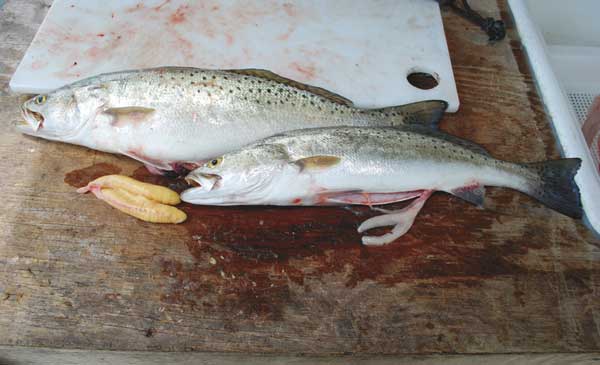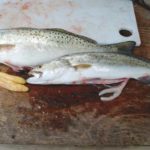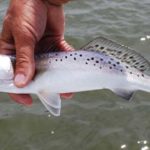
Anglers burn with passion over the seasonal movement of redfish to the jetties south of Calcasieu Lake.
This is the time of year when speckled trout fishing really heats up in the major bays and along the coast. In these high-salinity areas, specks prowl relentlessly, and greedily feed day and night all through the warm months.
Naturally, warm water temperatures play an important role. In cold-blooded creatures like trout, body temperatures and metabolic rates fluctuate with the temperature of the surrounding water. At low winter temperatures, their metabolism is slow, so speckled trout don’t need to feed heavily to provide fuel for their metabolic “fires.”
But the really big driver for the voracious feeding behavior of the fish at this time of year is their spawning needs. Speckled trout are prodigious sex machines, producing an incredible amount of eggs and sperm over a six-month reproductive season. Producing these gametes demands energy — lots of it.
They start early. Research indicates that 50 to 96 percent of female specks are sexually mature by age 1. Males mature even earlier than females, and some fish of both sexes begin spawning as small as 6 inches long.
In Louisiana, spawning begins some time in April and extends into September. Most authorities cite 76 degrees as the water temperature at which spawning begins in spring, although research shows some spawning activity as low as 68-71 degrees.
The reason that specks concentrate in the high-salinity areas of lower bays and along the coast in the summer also has to do with spawning. Speckled trout eggs need to float in the water to survive. If they sink to the bottom immediately after being laid, they will die.
High-salinity waters are denser than low-salinity waters, and provide more buoyancy for trout eggs. In low-salinity waters, most speckled trout eggs rapidly sink to the bottom. Little spawning takes place in salinities below 15 parts per thousand (ppt). For comparison, full strength seawater is 32-35 ppt.
Female speckled trout will spawn once every four to five days, or an incredible 40-50 times each season. Females produce from 8,400 to 11,200 eggs per ounce of body weight each time they spawn. Larger females tend to produce somewhat fewer eggs per ounce of body weight than smaller females, but their greater total weight means that large females will individually produce many more eggs than will small females. A very large female speck can produce as many as 60 million eggs per season.
While producing a sperm is not as large of an energy drain as producing an egg, male specks will spawn every night throughout the season, given the chance. Considering the energy demands of producing so many eggs and sperm, it is little surprising that trout feed ravenously during the summer.
Speckled trout spawn in large groups called “aggregations,” which in Louisiana typically form in high-salinity areas with good current flow and relatively deep water, such as passes between barrier islands and in shipping channels. Most drumming and spawning occurs in water depths of 6 to 33 feet, although modest amounts of drumming can occur in waters as deep as 113 feet.
Spawning begins when males aggregate at a site, usually before sunset. There, the males begin drumming by vibrating their gas bladders with bright red surrounding muscles called sonic muscles. The gas bladder is the tough, silvery-white tissue that so frequently interferes with a knife during filleting. It is assumed that the drumming is done to attract females.
Four types of sounds are made: a grunt followed by a series of knocks, several grunts strung together, a long grunt and a staccato of rap-rap-raps. Listening to a hydrophone lowered near an aggregation of spawning specks is an overwhelming experience. The individual knocks, raps and grunts meld into a deafening roar that makes one wonder if every speckled trout on earth isn’t present at that one spot.
Scientists can only speculate about the advantages and disadvantages of speckled trout announcing their spawning sites with noise. Apparently, the attraction of females to spawning sites with large numbers of males ready to spawn makes egg fertilization more efficient. The advantages of spawning in noisy groups must be great enough to offset disadvantages, such as the attraction of trout predators like bottlenose dolphins and bull sharks, which hunt by sound.
Drumming begins at about 6 p.m. and increases to a peak between 8 or 9 p.m., then decreases. By 11 p.m., drumming is almost over, although some calls are heard as late as 1 or 2 a.m. No male calling sounds are heard in the daytime, except those produced just before sunset.
During spawning, the trout in the school constantly mill, with light side-to-side body contact between the fish. Fertilized eggs are buoyant and float toward the surface, while unfertilized eggs sink.
Speckled trout drumming occurs on all moon phases, but is most common on the full moon or within three to four days after the moon. The lowest amount of calling is during the last quarter moon. First quarter moon periods have slightly more drumming than do new moon periods.
Jerald Horst is an author of the Angler’s Guide to Fishes of the Gulf of Mexico, a 444-page, color-illustrated book on fishes written for saltwater fishermen. The book is available in better bookstores or can be ordered by calling 800-843-1724.




